Reviewed: 28
This is a practical guide to Surface Science for researchers working in the Mining and Metals Industry.
In this all-new guide you’ll learn all about:
Let’s dive right in.

From ore extraction and processing to refining and fabrication, the mining and metals industry spans a wide array of operations crucial to global infrastructure and manufacturing. This industry is a cornerstone of global economic development. It provides basic resources for construction, manufacturing, infrastructure development, and technology sector.
Understanding and manipulating surface properties such as wettability, adhesion, and corrosion resistance are essential for optimizing processes, enhancing product quality, and ensuring operational efficiency.
We use the important surface properties below to understand the behavior of Mining and Metals products and improve their quality.
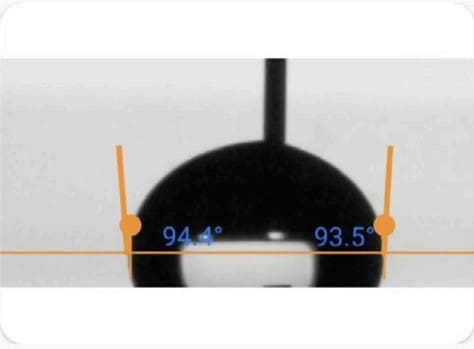
Young – Laplace Method
Polynomial Method
Dynamic Contact Angle
Ideally, when we place a drop on a solid surface, a unique angle exists between the liquid and the solid surface. We can calculate the value of this ideal contact angle (the so-called Young’s contact angle) using Young’s equation. In practice, due to surface geometry, roughness, heterogeneity, contamination, and deformation, the contact angle value on a surface is not necessarily unique but falls within a range. We call this range’s upper and lower limits the advancing contact angle and the receding contact angle, respectively. The values of advancing and receding contact angles for a solid surface are also very sensitive. They can be affected by many parameters, such as temperature, humidity, homogeneity, and minute contamination of the surface and liquid. For example, the advancing and receding contact angles of a surface can differ at different locations.
Practical surfaces and coatings naturally show contact angle hysteresis, indicating a range of equilibrium values. When we measure static contact angles, we get a single value within this range. Solely relying on static measurements poses problems, like poor repeatability and incomplete surface assessment regarding adhesion, cleanliness, roughness, and homogeneity.
In practical applications, we need to understand a surface’s liquid spreading ease (advancing angle) and removal ease (receding angle), such as in painting and cleaning. Measuring advancing and receding angles offers a holistic view of liquid-solid interaction, unlike static measurements, which yield an arbitrary value within the range.
This insight is crucial for real-world surfaces with variations, roughness, and dynamics, aiding industries like cosmetics, materials science, and biotechnology in designing effective surfaces and optimizing processes.
Learn how Contact Angle measurement is done on our Tensiometer
For a more complete understanding of Contact Angle measurement, read our Contact Angle measurement: The Definitive Guide
This property measures the force that acts on the surface of a liquid, aiming to minimize its surface area.
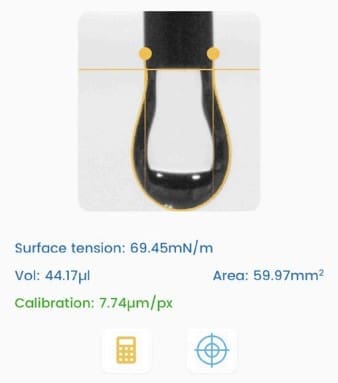
Dynamic Surface Tension
Dynamic surface tension differs from static surface tension, which refers to the surface energy per unit area (or force acting per unit length along the edge of a liquid surface).
Static surface tension characterizes the equilibrium state of the liquid interface, while dynamic surface tension accounts for the kinetics of changes at the interface. These changes could involve the presence of surfactants, additives, or variations in temperature, pressure, and composition at the interface.
Dynamic surface tension is essential for processes that involve rapid changes at the liquid-gas or liquid-liquid interface, such as droplet and bubble formation or coalescence (change of surface area), behavior of foams, and drying of paints (change of composition, e.g., evaporation of solvent). We measure it by analyzing the shape of a hanging droplet over time.
Dynamic surface tension applies to various industries, including cosmetics, coatings, pharmaceuticals, paint, food and beverage, and industrial processes, where understanding and controlling the behavior of liquid interfaces is essential for product quality and process efficiency.
Learn how Surface Tension measurement is done on our Tensiometer
For a more complete understanding of Surface Energy measurement, read our Surface Tension measurement: The Definitive Guide

Learn how Surface Energy measurement is done on our Tensiometer
For a more complete understanding of Surface Energy measurement, read our Surface Energy measurement: The Definitive Guide
The sliding angle measures the angle at which a liquid film slides over a solid surface. It is commonly employed to assess the slip resistance of a surface.
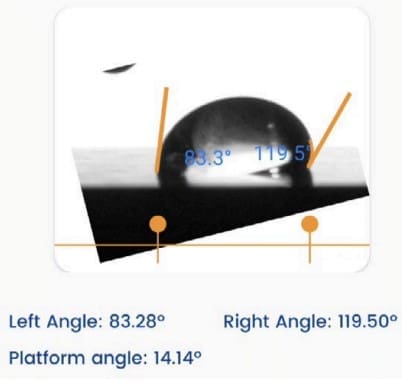
Learn how Sliding Angle measurement is done on our Tensiometer
For a more complete understanding of Sliding Angle measurement, read our Sliding Angle Measurement: The Definitive Guide
Within the Mining and Metals industry, several case studies exemplify the advantages of conducting surface property measurements.
Challenge: Achieving efficient flotation in both copper and gold mining is crucial yet complex due to the need for selective attachment of valuable minerals to air bubbles while controlling wetting behavior and surface tension.
Solution: Flotation in mining relies heavily on the interaction between mineral particles and air bubbles. For copper mining, optimizing the contact angle is vital for selectively floating copper minerals and repelling gangue minerals like silica. Achieving an ideal contact angle of 00 ensures hydrophobicity, leading to a high-quality copper concentrate.
In gold mining, controlling surface tension is essential for creating a stable froth. This froth enables gold particles to attach to air bubbles and be separated effectively from gangue materials. Proper surface tension values ensure air bubbles have sufficient buoyancy and stability to carry gold particles to the surface, facilitating efficient recovery.

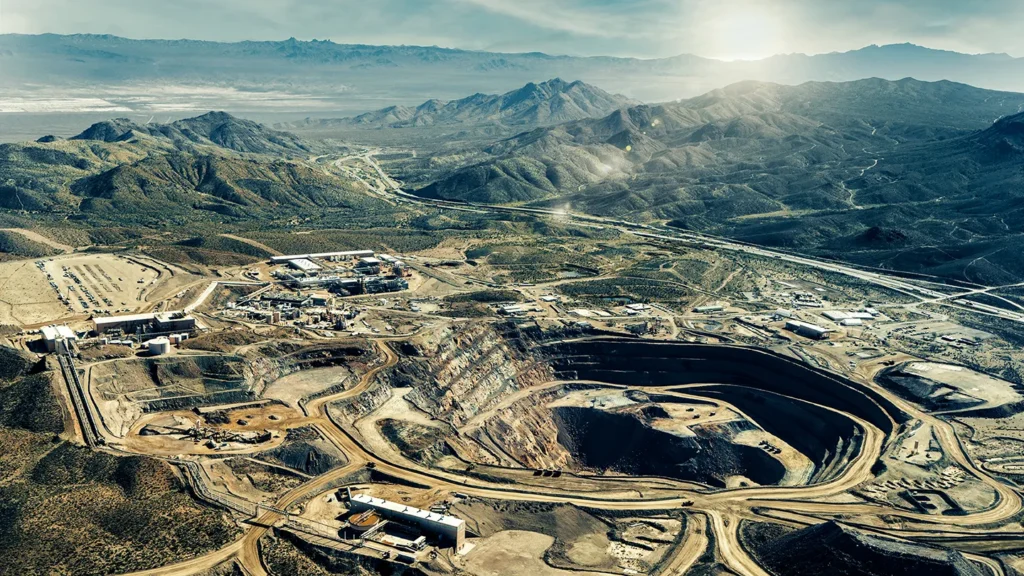
Challenge: Rare earth element extraction involves complex separation processes dependent on surface interactions.
Solution: The interactions between the mineral surfaces and chemical reagents used in the separation process are influenced by the surface energy. For example, rare earth elements (REE) often exist in complex mineral matrices with other elements. For the selective extraction of REE, chemical reagents are used. Miners can optimize the surface energy values so that these reagents can effectively adhere to the mineral surfaces containing REEs.
Similarly, surface energy optimization can be very useful in the selective extraction of minerals. By modifying surface energy, it’s possible to make the mineral surfaces more or less attractive to specific reagents, thus promoting the selective attachment of reagents to REE-bearing minerals while repelling unwanted minerals.
Challenge: The formation of rust and the durability of mining equipment is of great concern in the Mining Industry.
Solution: One of the established methods to prevent corrosion and wear on mining equipment is using hydrophobic coatings. Applying hydrophobic coatings with a high contact angle helps repel water and corrosive substances, preventing the formation of rust and enhancing the durability of mining equipment. And therefore, mining companies apply a hydrophobic coating to the surface of their conveyor belts and ore processing machinery. The increased contact angle ensures that water and corrosive minerals are repelled, reducing maintenance costs and extending the lifespan of the equipment.
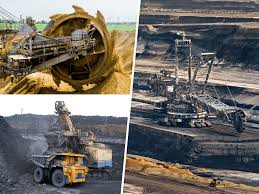
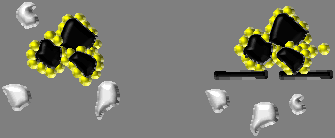
Challenge: Comminution is carried out to release valuable components, and the effectiveness of the subsequent separation heavily relies on the extent of this liberation. Nonetheless, the efficiency of concentration processes is compromised by the presence of fine particles generated during the grinding phase in mineral processing operations.
Solution: An approach to extract fine valuable minerals from slimes involves augmenting their size through selective oil agglomeration. To achieve successful mineral agglomeration with oil, it is imperative that the solution’s surface tension surpasses the critical surface tension required for oil agglomeration. This selective oil agglomeration method is applied to segregate valuable minerals from mixtures of fine particles, facilitating the aggregation of the targeted mineral. Consequently, industries can refine the oil agglomeration process to attain effective comminution.
If you are interested in implementing these or any other applications, please contact us.
In an industry where precision reigns supreme, where do Mining and Metals manufacturers turn to ensure their products can survive scrutiny? The answer lies in standards and guidelines: the compass that guides cosmetics manufacturers through the complex maze of quality and performance.

This standard provides the rock-mechanics terms commonly used in mining. The terms like ‘moisture content’, ‘angle of internal friction’, ‘basic sliding angle of friction of joint’, ‘roughness’, ‘angle of friction of fracture’, ‘rock burst’, ‘surface force’, ‘porosity’, ‘effective porosity’, ‘surface porosity’ are specified in this standard.
We hope this guide showed you how to apply surface science in cosmetics industry.
Now we’d like to turn it over to you:
Droplet Lab was founded in 2016 by Dr. Alidad Amirfazli, faculty member at York University, and two of his researchers, Dr. Huanchen Chen and Dr. Jesus L. Muros-Cobos.
Dropletlab © 2024 All Rights Reserved.